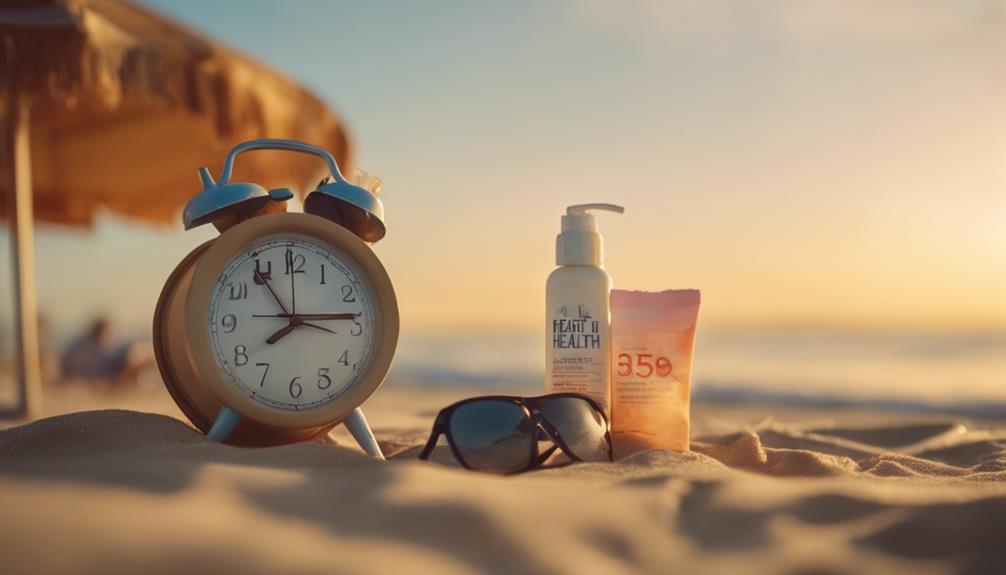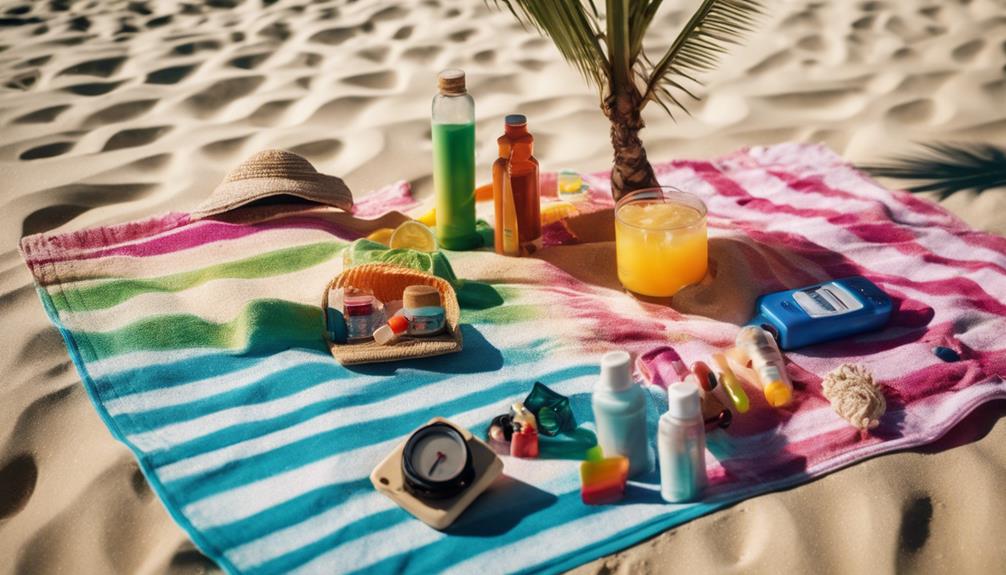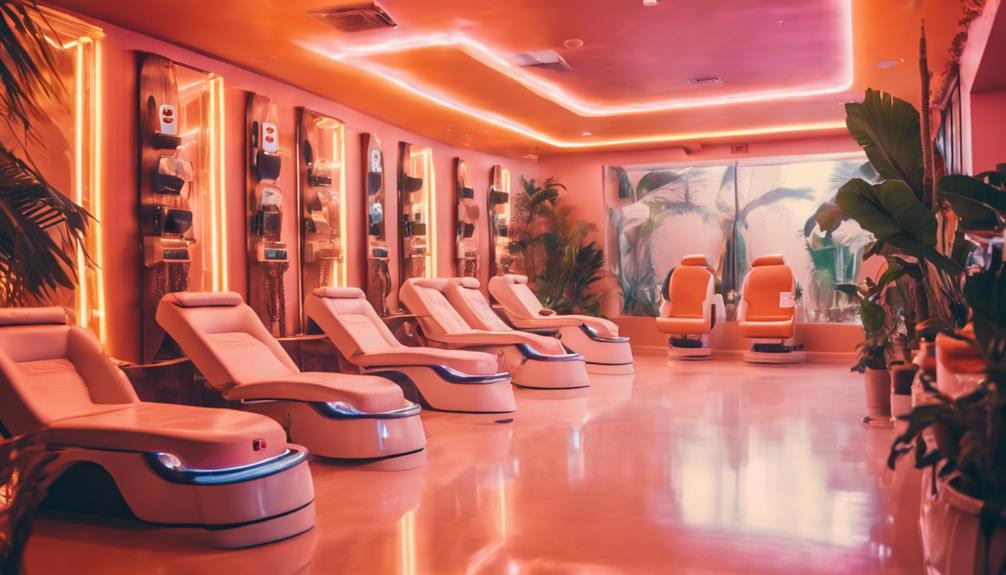Limiting your visits to tanning salons is essential for your health. Indoor tanning can increase your risk of skin cancers like melanoma, especially if you start young. The UV exposure from tanning beds causes cumulative skin damage and accelerates skin aging, leading to wrinkles and other concerns. Instead of tanning beds, consider safer alternatives like self-tanners or airbrush tanning for a sun-kissed look without the risks. It's also important to track your tanning habits and set limits based on health guidelines. Understanding the full scope of tanning's risks will help you make safer choices moving forward.
Key Takeaways
- Set a maximum number of indoor tanning sessions per month to reduce cumulative UV exposure and skin damage.
- Record the duration and frequency of tanning visits to monitor and limit your tanning habits effectively.
- Schedule regular skin checks for any new or changing moles to catch potential issues early.
- Educate yourself about the risks of indoor tanning to make informed decisions about your health.
Health Risks of Tanning
Tanning beds substantially increase your risk of developing skin cancers, including melanoma, basal cell carcinoma, and squamous cell carcinoma. When you expose your skin to the intense UV light from these beds, you cause cumulative damage that raises your cancer likelihood.
Many people mistakenly believe indoor tanning is safe, but statistics reveal a strong link between these practices and skin cancer. Not only does this result in a heightened risk, but it also accelerates skin aging, leading to wrinkles and stretch marks.
Additionally, indoor tanning doesn't offer health benefits like vitamin D production or mood enhancement. By understanding these risks, you can make informed choices about your skin health and avoid the dangers associated with tanning beds.
Safer Tanning Alternatives
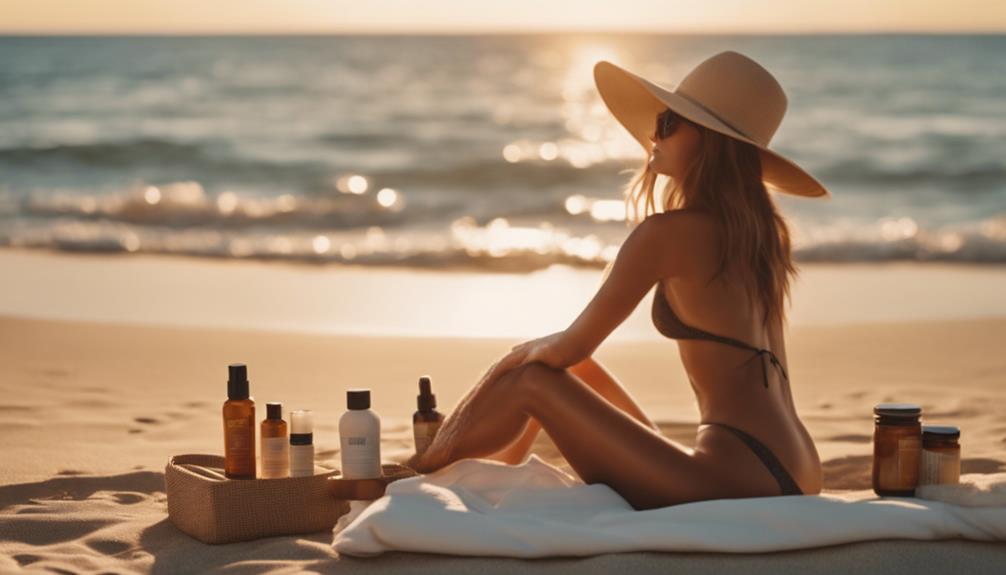
Reflect on self-tanners and airbrush tanning as safer alternatives that provide a beautiful, sun-kissed glow without the harmful UV exposure. These options allow you to achieve a radiant look while minimizing skin damage and health risks.
Here are some effective choices to reflect on:
- Self-tanners: Use products designed for a natural-looking tan without UV rays.
- Airbrush tanning: Opt for professional services to guarantee an even and flawless finish.
- Gradual tanners: Mix self-tanner with your moisturizer for a subtle, buildable color.
With these alternatives, you can feel confident in your appearance while protecting your skin's health.
Safe Tanning Practices
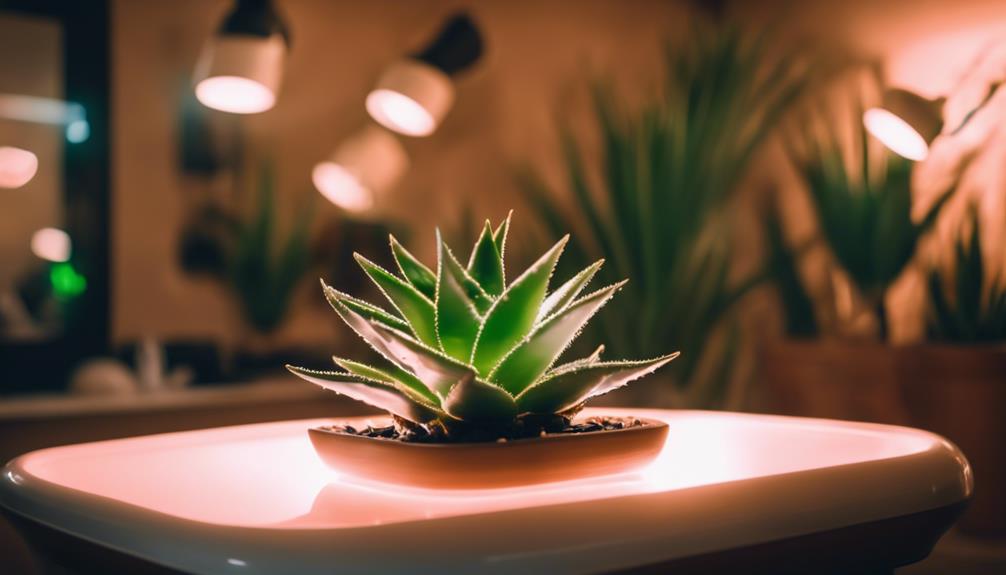
Achieving a healthy glow can be done safely by adopting practices that protect your skin while still allowing you to enjoy the benefits of a tan.
Start by opting for self-tanners, which provide a sun-kissed look without UV exposure. If you prefer a professional touch, consider airbrush tanning for an even finish.
Always apply sunscreen when enjoying outdoor activities to shield your skin from harmful rays. If you choose indoor tanning, limit your sessions and wear protective eyewear to safeguard your eyes.
Prior to tanning, prepare your skin by exfoliating and moisturizing, and afterward, keep your skin hydrated with a good moisturizer.
Avoid exfoliation post-tan to maintain your color and skin integrity.
Managing Tanning Habits
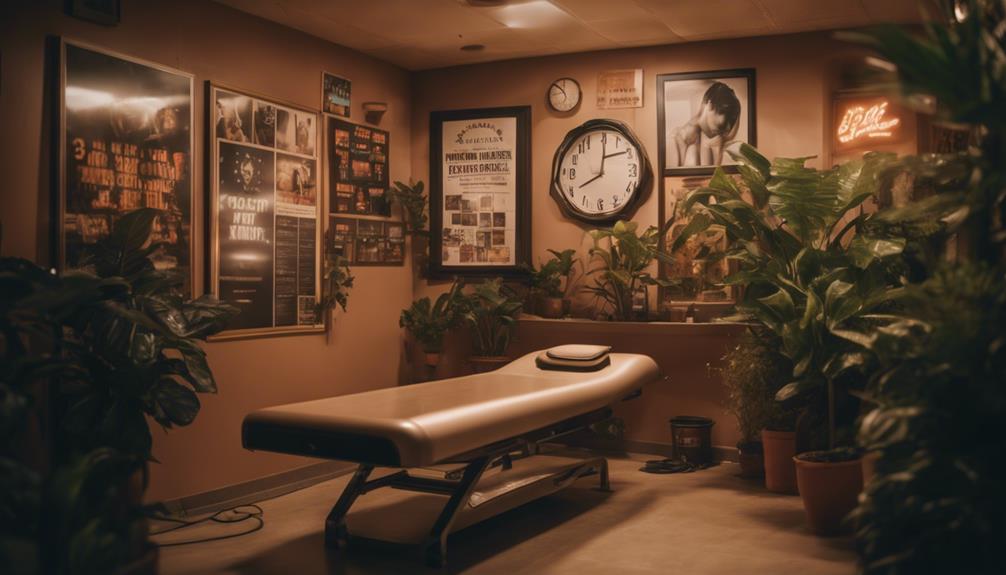
To maintain healthy tanning habits, keep track of how often you tan and monitor any changes in your skin. By staying aware of your tanning frequency, you can reduce your risk of skin damage.
Here are a few tips to help you manage your tanning habits:
- Record your tanning sessions to monitor frequency and duration.
- Regularly check your skin for new or changing moles and freckles.
- Set limits on indoor tanning to align with health recommendations.
Importance of Skin Care
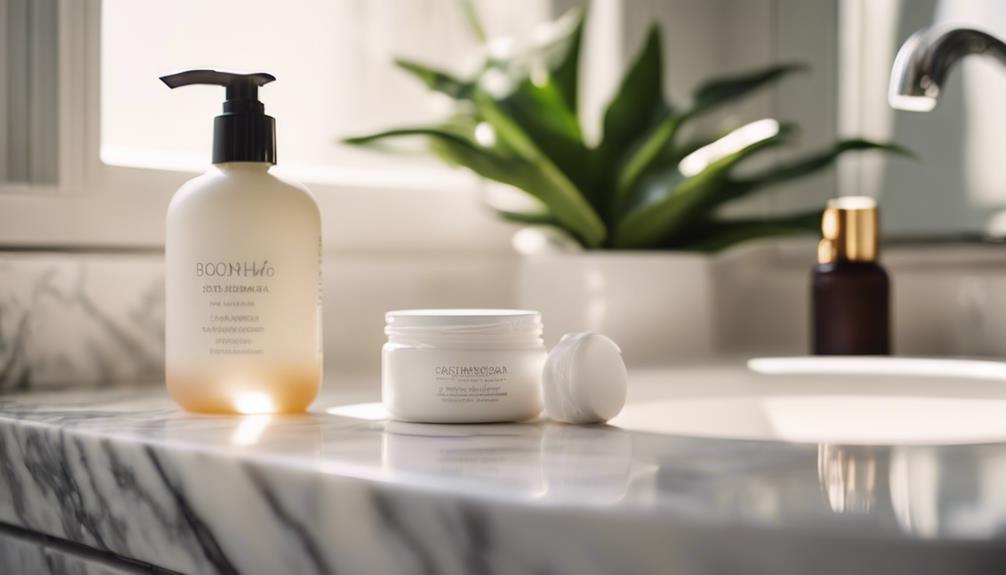
Prioritizing skin care is essential for maintaining healthy skin and minimizing the risks associated with tanning. By adopting a consistent skin care routine, you can protect your skin from damage and premature aging. Here's a quick overview of key skin care practices you should follow:
| Skin Care Practice | Benefits |
|---|---|
| Use sunscreen daily | Protects against UV damage |
| Moisturize regularly | Keeps skin hydrated and supple |
| Exfoliate weekly | Removes dead skin cells |
Incorporating these practices into your daily life not only enhances your skin's appearance but also reduces the likelihood of skin issues. Remember, taking care of your skin now can lead to a healthier, more radiant complexion in the future.
Tanning Equipment Hygiene
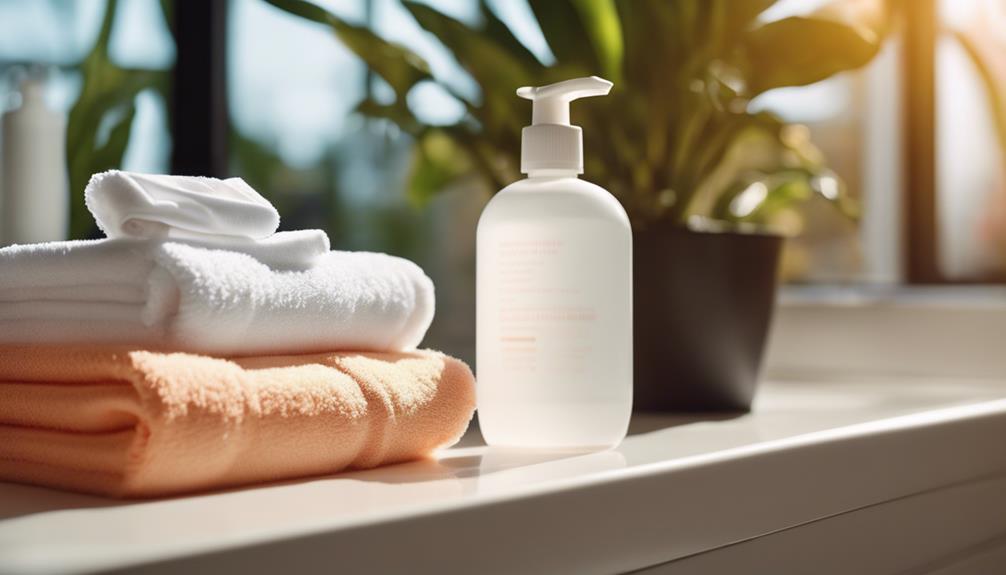
Maintaining proper hygiene for tanning equipment is essential for preventing bacterial growth and guaranteeing a safe tanning experience. When you use tanning beds, you should be aware of the cleanliness of the equipment.
Here are some hygiene tips to keep in mind:
- Always choose a salon that follows strict cleaning protocols.
- Confirm the tanning bed is cleaned with EPA-approved disinfectants after each use.
- Bring your own towel to lay on the bed for added protection.
Understanding Tanning Regulations
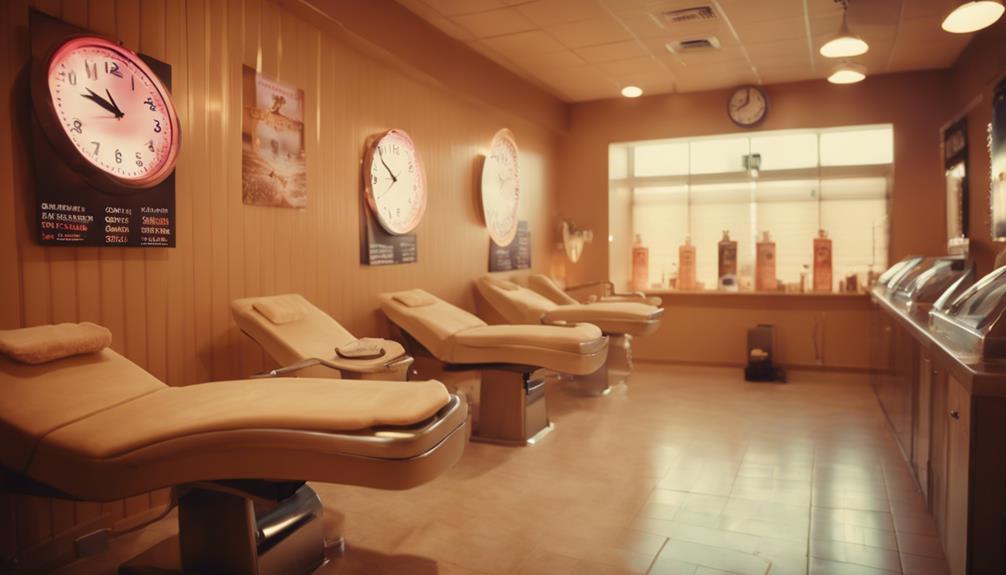
Understanding tanning regulations is essential for guaranteeing your safety and minimizing health risks associated with indoor tanning. Different regions have specific rules aimed at protecting you, such as age restrictions and mandatory informed consent. Familiarize yourself with these regulations to make informed choices about your tanning visits.
| Regulation Type | Description | Purpose |
|---|---|---|
| Age Restrictions | Many places prohibit tanning under 18 | Protects minors from harmful UV exposure |
| Informed Consent | Clients must acknowledge risks before tanning | Guarantees awareness of health risks |
| Session Limits | Guidelines on maximum sessions per week | Reduces cumulative UV damage |
| Equipment Standards | Beds must meet safety and hygiene standards | Guarantees proper maintenance and safety |
Stay informed and prioritize your skin health!
Frequently Asked Questions
How Can I Tell if My Tanning Habits Are Excessive?
You can tell your tanning habits are excessive if you notice skin changes, like new moles or freckles, experience unwanted skin aging, or feel anxious about not tanning. Regularly tracking your sessions can help manage your habits.
What Should I Do if I Get Burned From Tanning?
If you've burned yourself from tanning, don't panic like it's the end of the world! Immediately cool the skin with aloe vera, hydrate, and avoid further sun exposure until it heals. Your skin will thank you!
Are There Specific Skin Types That Should Avoid Tanning Altogether?
Absolutely, if you have fair skin, a history of skin cancer, or conditions like eczema, you should avoid tanning altogether. Your skin's sensitivity makes it more vulnerable to damage and increased cancer risk.
Can Tanning Affect My Acne or Skin Conditions?
You might think tanning clears up acne, but it can actually worsen skin conditions. UV exposure often inflames skin, leading to breakouts or irritation. Consider safer alternatives for managing acne without risking additional skin issues.
How Often Should I Get Skin Check-Ups After Tanning?
You should get skin check-ups every six to twelve months after tanning. Regular check-ups help spot any changes or issues early, ensuring your skin stays healthy and reducing the risk of serious conditions.
Why is it important to limit tanning salon visits for health?
Limiting tanning salon visits is crucial for health, as tanning bed sanitization safety must be a top priority. Overexposure to UV radiation can lead to skin cancer and premature aging. By controlling the frequency of tanning sessions, individuals can reduce their risk of these harmful effects and prioritize their overall well-being. It is also important to follow safe tanning hygiene tips, such as wearing protective eyewear and using sunscreen to minimize the risk of skin damage. Additionally, individuals should be aware of the signs of skin damage and regularly check their skin for any irregularities. By taking these precautions and limiting tanning salon visits, individuals can enjoy a healthy glow while minimizing their risk of potential health issues.
Conclusion
To sum up, limiting your visits to tanning salons is crucial for protecting your skin and overall health. To protect your skin, take proper precautions when visiting tanning salons. This includes using protective eyewear, avoiding overexposure, and following hygiene tips for tanning safely. Applying a high SPF sunscreen and moisturizing regularly can also help minimize UV damage. Remember, tanning should be done in moderation and always prioritize your health when considering visiting a tanning salon.
Why risk serious conditions like skin cancer for a temporary glow?
By embracing safer tanning alternatives and adopting smart practices, you can achieve a beautiful tan without compromising your well-being.
Remember, prioritizing your skin care and maintaining hygiene with tanning equipment are essential steps in your journey to healthier skin.
Choose wisely, and let your natural beauty shine through!
